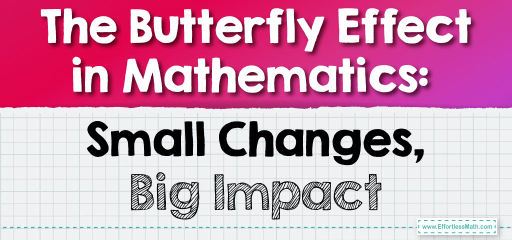The Butterfly Effect in Mathematics: Small Changes, Big Impact

Weather forecasting
Financial markets
Financial markets significantly rely on the butterfly effect. The market moves billions of money daily. On the board, a trader might be observing and ignoring small changes. When multiplied with numbers, the slightest change could mean the biggest loss or gain. The effect works perfectly in other areas such as population growth and navigation. It is applied in space exploration and biological systems.
Taking care of chaos by applying the butterfly effect
Chaos in life could have devastating negative effects but they can also bring lasting positive outcomes. People go through chaos in terms of disasters, pandemics, climate change, and effects on the supply chain. When Lorenz first explained the butterfly effect, many people including scientists kept asking if the butterfly effect real.
Sometime later, his idea began to be used in chaos theory. The theory to date is used to forecast how unpredictable situations or systems might behave if there were slight changes in the initial condition. Through the years, scientists have used the butterfly effect to understand changes in climate due to slight changes in things such as C02.
After realizing the significant changes the small things cause, they believed Lorenz’s definition was real. They realized the effect is applied daily in life and many times people don’t even realize it. When they define the butterfly effect, scientists argue that chaos can be beneficial to humans.
They argue that the important point is to understand how to control chaos and use them to your advantage. In math, the concept uses strategies of controlling complex formulas or problems to get insights. Through these insights, people can develop solutions that last. Based on science, solutions come by destabilizing the chaos. The differences might be minute or delicate but they create an opportunity to discover more things that might have never been possible.
Manipulation is not the butterfly effect idea
In his book titled Team of Teams, General Stanly explained that the butterfly effect does not rely on manipulation. He explains that people misunderstand the effect and base it on the impact of leveraging. To leverage, they manipulate things hoping they will give a butterfly effect outcome. Stanley notes that this is a misuse of the phrase and Lorenz’s idea. Based on Lorenz, it is impossible to predict whether the small changes will cause a positive or negative outcome. It is not possible to predict how massive the change will be. It can be a small or big outcome.
Geologists study the happenings deep into the earth and give numerical explanations. Based on studies, the slightest change in tectonic plates can cause huge volcanic or seismic activity. The outcomes at other times are minute and never felt on the surface of the earth. It is impossible to manipulate them but geologists can only give numerical tables or graphs to explain what might happen and prepare the people.
Phrases used to explain the butterfly effect
Experts and ordinary people have used different butterfly phrases to explain the effect. Here are some of them.
- “Never undervalue the power of a butterfly’s flutter.” “It can cause a global cyclone.” (FSM Statistics)
- “Butterflies recognize the beauty in transformation.” (Anonymous)
- In the Amazon rainforest, a butterfly flicks its wings.” “A hurricane rips through half of Europe.” (Neil Gaiman)
- “Modify one item, alter everything.” (Verändere Zukunft)
Conclusion
The butterfly effect was first explained by Edward Lorenz as he observed the significant effect small changes had on weather patterns. The phrase was adopted in math and used to explain chaos theory. Today, the butterfly effect concept is applied in many areas of science and art. It is used to explain how to take advantage of chaos to create lasting solutions.
Related to This Article
More math articles
- The Ultimate 7th Grade DCAS Math Course (+FREE Worksheets)
- Top 10 ISEE Lower Level Prep Books (Our 2026 Favorite Picks)
- How to Multiply Mixed Numbers? (+FREE Worksheet!)
- 10 Most Common ParaPro Math Questions
- How to Solve Arithmetic Sequences? (+FREE Worksheet!)
- Top 10 SSAT Middle Level Prep Books (Our 2023 Favorite Picks)
- The Ultimate ASVAB Math Formula Cheat Sheet
- Top 10 4th Grade PARCC Math Practice Questions
- The Ultimate 7th Grade WVGSA Math Course (+FREE Worksheets)
- 5 Best Programmable Calculators






































What people say about "The Butterfly Effect in Mathematics: Small Changes, Big Impact - Effortless Math: We Help Students Learn to LOVE Mathematics"?
No one replied yet.